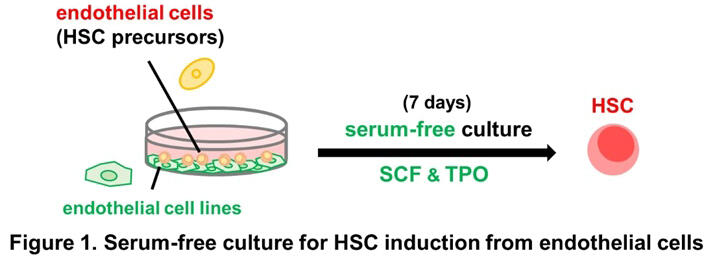A group led by Assistant Professor Saori Koga and Professor Minetaro Ogawa of the Institute of Molecular Embryology and Genetics at Kumamoto University has announced that they successfully induced the in vitro differentiation of hematopoietic stem cells from vascular endothelial cells, which are the progenitor cells of hematopoietic stem cells. This was achieved by reproducing the environment necessary for hematopoietic stem cell development from vascular endothelial cells. Because of its versatility, i.e., without the need for genetic modification or the addition of serum or other biological materials, this method is expected to become a powerful research tool for clarifying the detailed mechanisms of hematopoietic stem cell development. The results were published in the Proceedings of the National Academy of Sciences of the United States of America (PNAS) on July 23.

Hematopoietic stem cells, which are found in bone marrow, continue to replicate and produce blood cells throughout life. The disruption of hematopoiesis or genetic abnormalities during the development of hematopoietic stem cells can cause hematological diseases. If the normal developmental process of hematopoietic stem cells can be reproduced in vitro, the effects of genetic mutations can be explored to clarify the causes of these diseases.
However, the in vitro differentiation of hematopoietic stem cells from vascular endothelial cells required co-culturing with genetically modified feeder cells or culturing in the presence of serum. This requirement made in vitro differentiation non-versatile, and the elucidation of the mechanisms was precluded by the effects of cytokines and other substances in serum.
In this study, the researchers aimed to overcome these issues and construct a serum-free method for inducing hematopoietic stem cell differentiation exclusively using materials with easy accessibility. Hematopoietic stem cells arise from aortic endothelial cells during embryonic development via pre-hematopoietic stem cells.
In response to this, they searched for signaling factor receptors expressed by pre-hematopoietic stem cells in mouse embryos and found that KIT, a stem cell factor (SCF) receptor, and MPL, a thrombopoietin (TPO) receptor, were expressed. Pre-hematopoietic stem cells were cultured in serum-free culture medium supplemented with SCF and TPO and differentiated into hematopoietic stem cells. Differentiation did not occur when only one of the two was added.
Furthermore, they searched for conditions for vascular endothelial cell differentiation into hematopoietic stem cells. They also found that a vascular endothelial cell line needed to be added as a feeder cell line for vascular endothelial cells. SCF, but not TPO, is present in the aortic lumen where vascular endothelial cells develop in embryos. Because TPO is produced only by hepatoblasts, pre-hematopoietic stem cells migrate from the aortic lumen to the liver where they receive TPO signals and differentiate into hematopoietic stem cells.
Koga said, "Since the culture method established in this study uses only research tools that are readily available to researchers around the world, it is expected that it will become the standard protocol for detailed research into the developmental process of hematopoietic stem cells. Our future goal is to establish a culture technology that reproduces the developmental process from pluripotent stem cells to hematopoietic stem cells. We aim to conduct research that will contribute to medical care, including applications to regenerative medicine and exploration of disease causes."
Journal Information
Publication: PNAS
Title: Transition of signal requirement in hematopoietic stem cell development from hemogenic endothelial cells
DOI: 10.1073/pnas.2404193121
This article has been translated by JST with permission from The Science News Ltd. (https://sci-news.co.jp/). Unauthorized reproduction of the article and photographs is prohibited.




